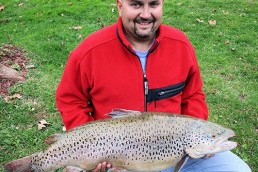MoNews
Spring turkey hunters harvest 43,339 birds
Preliminary data from the Missouri Department of Conservation (MDC) shows that turkey hunters checked 39,239 birds during Missouri’s 2017 regular spring turkey season April 17 through May 7. Top harvest counties were Franklin with 932 birds checked, Texas with 843, and Callaway with 697. Young turkey hunters harvested 4,100 birds during the 2017 spring youth season, April 8-9, bringing the overall 2017 spring turkey harvest to 43,339.
The 2016 overall spring turkey harvest was 48,374 birds with 4,167 harvested during the youth weekend and 44,207 during the regular spring season.
“Given that we haven’t had good hatches the past couple years, and the less-than-ideal weather during a considerable portion of this year’s season, the drop in harvest compared to last year was not unexpected,” MDC Turkey Biologist Jason Isabelle said.
Missouri offers some of the best turkey hunting in the nation. MDC restoration efforts in past decades have taken this popular game bird from almost being wiped out in the state by the 1950s, to an estimated population of more than 300,000 birds today. Missouri turkey hunters spend more than $125 million each year on related travel, food, lodging, and hunting equipment, which helps local businesses and the economy.
See more data on spring turkey harvest numbers by county at: http://on.mo.gov/1jjz7Ew.
Missouri student archers crowned national champions
The National Archery in the Schools (NASP) National Tournament and NASP International Bowhunting Organization (IBO) 3D Challenge were held this past May in Louisville. More than 14,490 student archers in grades 4-12 from 670 schools competed, including 857 Missouri students from 45 schools.
Missouri’s Sarcoxie High School was crowned national champions with a record-setting score of 3,465 out of 3,600. Sarcoxie High School is also the smallest school to win the national championship.
“Sarcoxie didn’t get involved in NASP until five years ago, and to go from just starting to national champions in that short amount of time is simply amazing,” said Eric Edwards, MDC’s MoNASP coordinator.
Missouri dominated the high school team division with five of the top ten teams. Sarcoxie High School took first, Hillsboro High School was sixth, Carl Junction High School took seventh, Lee’s Summit West High School was eighth and Carthage High School took ninth out of 248 high school teams.
Junior Anna Reinkemeyer from Helias High School took third place in the high school female division. Freshman Trenton Meyer from Carthage High School took fifth place in the high school male division. Junior Frankie Goforth from Carl Junction High School and freshman Kamyrn Twehus from Blair Oaks High School tied for sixth place in the high school female division. Seventh grader Irvin Johnson from Salem Middle School took fifth place in the middle school boys division. Eighth grader Jeremiah Jones from Carl Junction Middle took eighth place in the middle school boys division.
NASP promotes education, self-esteem, and physical activity for students in grades 4-12 through participation in the sport of archery. Since NASP’s beginnings in 2002, more than 10 million students have participated in the program.
Ducks Unlimited Missouri chapter earns spots on Chairman’s Roll of Honor list The Chairman’s Roll of Honor chapters are among Ducks Unlimited’s most prestigious volunteer chapters throughout the nation. Every year, the list is reserved for the chapters that raise $250,000 to $1 million for DU’s habitat conservation work.
In 2016 in Missouri, the St. Louis Sponsors chapter made the Chairman’s Roll of Honor list.
“These fundraising events are the backbone of DU’s habitat conservation efforts, and the volunteers who make up these chapters are the force making a difference for North American waterfowl populations,” said Paul Bonderson, DU president.
St. Louis Sponsors earned a spot on the Chairman’s Roll of Honor list out of the more than 2,600 DU chapters nationwide that host more than 3,900 fundraising events throughout the year. DU has funded a significant portion of the more than 13.8 million acres of wetlands and associated habitat since 1937.
“DU chapters across the country are showing that the future of waterfowl populations and the wetlands that filter our water and protect us from flooding are important to them and to their communities,” Bonderson said. “The more money we raise, the more habitat we can conserve and the closer we are to preserving our waterfowl-hunting heritage. I would like to personally thank all our Chairman’s Roll of Honor chapters for their achievement and look forward to seeing them among our distinguished chapters next year.”
Established in 1937, Ducks Unlimited has conserved more than 13.8 million acres thanks to contributions from more than a million supporters across the continent. Guided by science and dedicated to program efficiency, DU works toward the vision of wetlands sufficient to fill the skies with waterfowl today, tomorrow and forever.
What fishing means to Missouri’s economy
The American Sportfishing Association (ASA) and Southwick Associates released the 2017 update of Economic Contributions of Recreational Fishing: U.S. Congressional Districts. The update depicts recreational fishing’s economic impact on all 435 congressional districts and the 50 states.
America’s 46 million anglers generate more than $48 billion in retail sales with a $115 billion impact on the nation’s economy, creating employment for more than 800,000 people.
Recreational fishing is the foundation of an industry that involves not just the manufacturing, sale, or provision of tackle and other fishing gear, but also includes services such as boat builders, hotels, restaurants and much more.
“A top priority for members of Congress is the ability to identify jobs and economic opportunity in their districts,” said Mike Leonard, ASA conservation director. “By identifying recreational fishing’s economic impact at the congressional district level, we can clearly show members of Congress that recreational fishing in their district or state is a tremendous economic driver and job creator.”
According to the ASA, over 1.5 million anglers in Missouri spent $684.8 million in 2016, which created an economic output of $1.1 billion and supported 10,841 jobs.
MWO
SHARE THIS POST
Did you enjoy this post?
You can be among the first to get the latest info on where to go, what to use and how to use it!
Darrell Taylor
Darrell Taylor has fished for more than 65 years. During the past 25 years, Taylor has generated more than 2,000 published articles, columns and fishing reports. His writings received 14 peer-level awards from outdoor writer organizations, including the Association of Great Lakes Outdoor Writers “Excellence in Craft” Golden Glow Award, their highest recognition.


